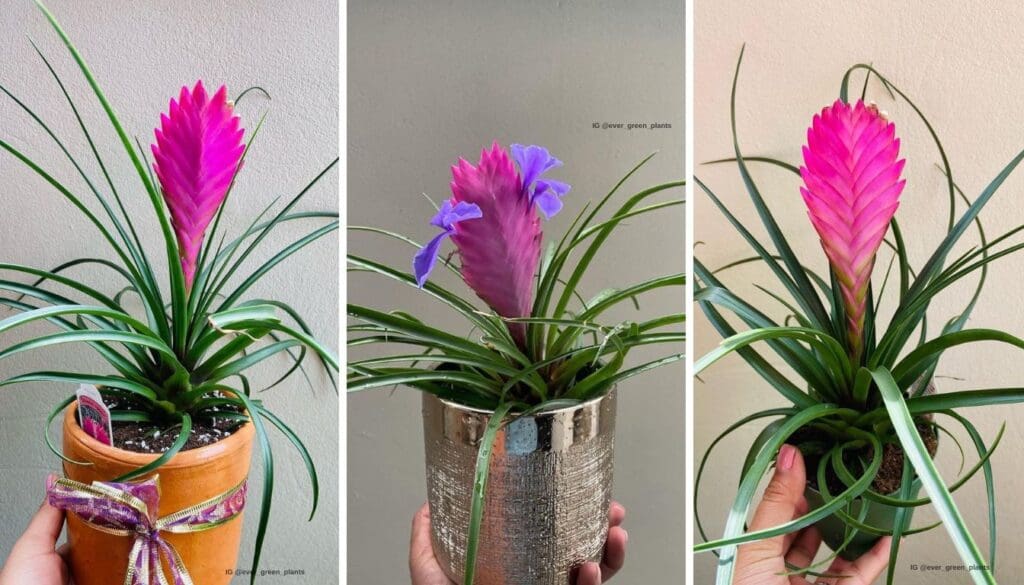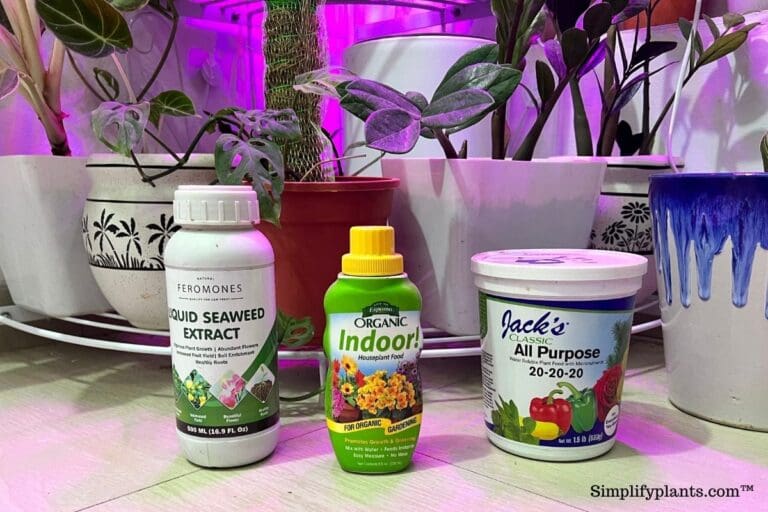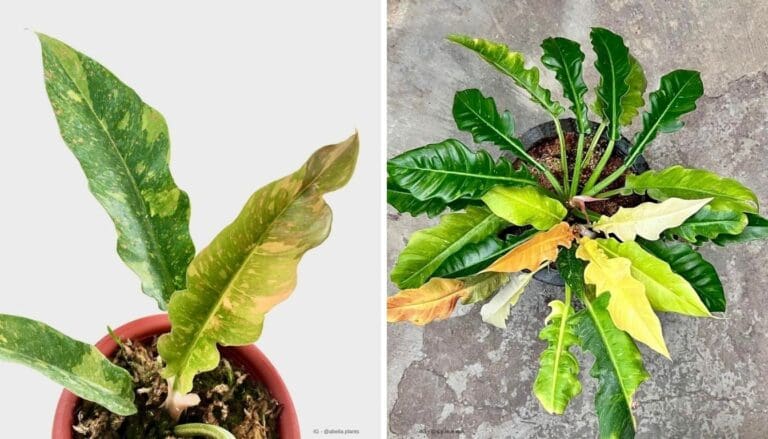Pink Quill Plant Care: Tips for Thriving Blooms
The Pink Quill Plant, also known as Tillandsia cyanea, is a unique and eye-catching addition to any home. Its vibrant pink bract and delicate blue flowers make it a standout on any windowsill.
The best part? It’s relatively easy to care for, requiring just a few simple steps to keep it happy and thriving.
One of the main things I’ve learned is that bright, indirect light is crucial.
I keep mine near an east-facing window where it gets lots of light without the harsh midday sun. This helps prevent those pesky sunburned leaves. 💡
And for watering, remember less is more.
Don’t drench the soil; a light misting a couple of times a week works wonders.
Another tip I’ll never forget is using the right potting mix.
A blend of bark, perlite, and peat moss keeps the roots healthy and secure. 🌿
It’s like giving your Pink Quill Plant a comfy bed to rest and grow.
Have you tried these tips with your Pink Quill? Share your experience in the comments below!

Please note: Simplify Plants is reader-supported. As an Amazon Associate, I earn from qualifying purchases made by our readers with no extra cost added to you all! Some links in the post are affiliate links and I get a commission from purchases made through links in the post.
Basic Pink Quill Plant Profile
The Pink Quill Plant, or Tillandsia cyanea, is a beautiful air plant known for its striking pink bracts and small blue flowers. It’s a relatively easy plant to care for, making it a favorite among plant enthusiasts. Let’s explore its species details and growth habits.
Species Overview
The Pink Quill Plant is part of the Tillandsia genus which includes many air plants. Unlike most air plants, it roots in soil, making it a bit unique.
The plant gets its name from its vibrant pink bract that looks like a quill. 🌸
These plants thrive in bright, indirect light and do best in a humid environment.
Misting the plant regularly or placing it on a pebble tray with water helps maintain moisture.
This plant is relatively low-maintenance, enjoying temperatures between 60-80°F. How easy is that?
Typical Growth Patterns
One cool thing about the Pink Quill Plant is its long-lasting bract that can stay colorful for 2-4 months!
The tiny blue or purple flowers that pop out only last a few days, but they’re so pretty.
It usually doesn’t get very big, reaching about 10-12 inches in height and width.
The leaves are thin and arching, and they form a rosette that’s quite eye-catching.
If you’re patient, you might find that it also produces offshoots (pups) that you can propagate to grow new plants. Ever tried propagating plants before? It’s quite fun!
So, what do you think? Are you ready to add a Pink Quill Plant to your collection? Let me know in the comments! 🌿💬
Optimal Growing Conditions

Taking care of your Pink Quill Plant means paying attention to light, temperature, and humidity. These factors will help your plant thrive and show off its beautiful blooms.
Light Requirements
Your Pink Quill Plant loves bright, natural light.
The best spot is near an east, south, or west window, but not in direct sunlight. This helps the plant flower and look its best.
I recommend using sheer curtains if the sun is too strong because it can scorch the leaves.
Low-light conditions? No problem! The Pink Quill can tolerate them, though it won’t flower as much.
So, if you want more blooms and a happier plant, find a spot with plenty of indirect sunlight.
Temperature Preferences
The Pink Quill Plant enjoys temperate climates.
Ideally, keep it in places with temperatures between 60-80°F (16-27°C). It’s like us enjoying a comfortable room temperature!
Avoid cold drafts and sudden temperature changes, as this plant prefers a stable environment.
It can manage slightly cooler conditions during the night, but don’t let it drop below 50°F (10°C). 🥶 Who likes being too cold, right?
Humidity Levels
Considering the Pink Quill Plant’s tropical origins, moderate to high humidity is ideal.
Aim for humidity levels of 50-70%. If your home is dry, especially in winter, a humidifier can be a great help.
You can also mist the plant with water to maintain the moisture it loves.
Placing it on a tray with pebbles and water is another simple trick to boost humidity. Just make sure the pot isn’t sitting directly in the water. Your Pink Quill will thank you with healthier, more vibrant leaves!
Do you have a Pink Quill Plant? Share your growing tips in the comments! 🌱✨
Planting and Potting

Let’s dive into the nuts and bolts of planting your Pink Quill Plant. We’ll look at the best type of soil, pot selection, and how to repot this beauty. 🌸
Soil Composition
The Pink Quill Plant loves a soil mix that mimics its natural habitat. A mix of bark, perlite, and peat moss works wonders.
This combination provides good aeration and ensures the roots don’t sit in water.
Have you ever overwatered a plant? It’s the worst! 😅 Using this soil mix helps prevent that problem by allowing excess water to drain out easily.
- Bark: Adds structure and aeration.
- Perlite: Improves drainage.
- Peat Moss: Retains the right amount of moisture.
Pot Selection and Drainage
Choosing the right pot is crucial.
Always go for a pot with drainage holes to prevent water from sitting at the bottom. This plant does not like “wet feet.” 🦶
Consider using a terracotta pot. These pots are porous, which allows excess moisture to evaporate, keeping the soil on the drier side. Plus, they give a nice earthy look to your decor. 🌿
Ensure your pot is big enough for the roots but not too spacious. You don’t want too much extra soil, which can hold excess water.
Repotting Guidelines
Over time, your Pink Quill Plant will outgrow its home.
When you see roots poking out of the pot or the plant appears too crowded, it’s time to repot.
Spring or early summer is the best time to do this.
Gently remove the plant from its current pot, taking care not to damage the roots.
Place it in the center of the new pot and fill around the roots with the fresh mix we talked about earlier. Make sure it’s secure but not too tight.
Once done, give it a good misting. 🚿
Remember, this plant absorbs water through its leaves more than its roots, so give those leaves some love! 💧
Got any repotting stories or tips? Share them in the comments below! Let’s help each other grow better plants. 🌱
Watering Schedule

Keeping your Pink Quill Plant hydrated is key. I like to check on mine about twice a week.
When I water my plant, I use about 0.8 cups of water each time.
This amount works great if your plant is in a 5-inch pot and not in direct sunlight. 🌿
Handy Tips for Watering:
- Misting: Mist the leaves thoroughly once or twice a week. Make sure both the leaves and the base get some love.
- Soaking: Every two weeks, I soak my plant in water for 20 minutes. It’s like a spa day for the plant and keeps it extra hydrated.
- Avoid Overwatering: It’s easier to bring back an underwatered plant than an overwatered one. So, when in doubt, go light!
How often do you check on your plants? Let me know in the comments! 😊
Fertilizing Routine

Proper fertilization is key to keeping your Pink Quill Plant healthy and vibrant. In this section, I’ll cover the best type of fertilizer to use and how often to use it.
Type of Fertilizer
For your Pink Quill Plant, a balanced formula fertilizer is the way to go.
Look for a water-soluble option with a ratio like 10-10-10 or 20-20-20. This means the fertilizer contains equal parts of nitrogen, phosphorus, and potassium, which are essential nutrients.
I prefer using one that’s specifically designed for epiphytic plants, as it suits the unique needs of the Pink Quill.
Remember to dilute the fertilizer according to the package instructions—overdoing it can harm the plant. 🌿
Frequency of Fertilization
So, how often should you fertilize your Pink Quill Plant?
During the growing season (spring to early fall), I recommend fertilizing once a month. This regular boost keeps the plant in top shape.
In the dormant season (late fall to winter), cut back on fertilization.
You can skip it altogether or do it very sparingly. 🛑
If your plant looks stressed, you might want to flush the soil with water to remove any excess fertilizer.
How often do you fertilize your plants? Share your routine below!
Pruning and Maintenance

Regular pruning and maintenance help keep your Pink Quill Plant looking its best and encourage healthy growth. Ready to get your hands a bit dirty and make your plant thrive? Let’s dive in!
Pruning Techniques
To start, always use clean, sharp scissors or pruning shears.
I trim away dead or yellow leaves first. This helps the plant focus its energy on new growth.
For the flowering bract, wait until the vibrant pink fades to brown. Then, cut it off near the base.
Make sure not to over-prune. Trim only what is necessary. This helps the plant stay healthier and less stressed.
After pruning, your plant might need slightly less water until new growth starts. Keep an eye on it to avoid overwatering.
Handling Flowering and Bromeliad Pups
When your Pink Quill Plant blooms, you’ll see a stunning display! 🌸
After the bloom fades, you can cut it off.
Did you know this plant will also produce pups? These mini plants grow from the base.
To separate the pups, wait until they are at least one-third the size of the mother plant.
Gently twist or cut them away with a clean blade. Plant them in their own pot with a mix of bark, perlite, and peat moss.
Are you excited to see your plant family grow? Share how your Pink Quill is doing in the comments! 🌿
Common Issues
The Pink Quill plant is generally easy to care for, but it can face a few common issues like pests and diseases. Knowing how to identify and address these problems can keep your plant healthy and thriving. 🌿
Pest Problems
Sometimes, I notice that the Pink Quill plant attracts mealybugs and spider mites. These little pests can be annoying, but they’re manageable.
Mealybugs look like tiny cotton balls on the leaves.
If you spot them, dab a bit of rubbing alcohol on a cotton swab and gently wipe them away.
Spider mites, on the other hand, create fine webbing on the leaves.
I usually wash them off with a strong water spray or use a mild insecticidal soap.
Regularly checking your plant and keeping the humidity up can prevent these pests from becoming a problem. 🌿🐛
Have you noticed any pests on your Pink Quill?
Disease Concerns
The Pink Quill plant can sometimes suffer from root rot if overwatered. It’s a common issue with many houseplants.
I make sure that the pot has proper drainage and the soil isn’t too wet.
Remember, less is more when it comes to watering!
Another disease is leaf spot, which appears as brown or black spots on the leaves.
If I see these spots, I trim the affected leaves and make sure not to wet the foliage when watering.
By being mindful of watering practices and maintaining good air circulation, these diseases can be avoided.
Have you had any issues with diseases on your plant? 🤔🌿 Let me know in the comments below!
Propagation Methods

I’m here to share some fun tips on how you can propagate your pink quill plant at home. Whether you’re a pro or a newbie, you’ll find this quite easy!
By Offsets
One of the best ways to propagate the pink quill is through offsets, also known as “pups.”
- Look for Pups: After the plant blooms, it will start producing little baby plants at its base.
- Separation: Gently separate these pups from the mother plant using a clean knife or scissors.
- Potting: Plant them in a fresh potting mix made of bark, perlite, and peat moss.
By Seeds
Seeds! Yes, you can grow new quills from seeds too, although it’s a bit trickier.
- Seed Collection: Wait for the flowers to wither and the seed pods to dry.
- Planting: Sprinkle the seeds on the surface of a moist, well-drained mix and cover lightly with soil.
- Care: Keep the soil moist and in a spot with indirect light.
Propagation can feel like a magical process! 💫 Have you tried it yet? If you have some awesome tips or want to share your experience, drop a comment below. Let’s grow together! 🌸
Do you have questions about propagating your pink quill? Ask away in the comments! 🗣️
Happy planting!
Troubleshooting Tips
Is your Pink Quill Plant not looking its best? Let’s get it back in shape! 🌿
Brown Leaf Tips
If the tips of the leaves are browning, the air might be too dry.
- I mist my plant regularly or place it on a tray with pebbles and water.
Yellowing Leaves
This can be a sign of overwatering.
- I always make sure the soil is dry before watering again.
No Blooms
Is your plant refusing to bloom? It might need more light.
- I place mine near a bright window, but not in direct sunlight.
Drooping Plant
If your Pink Quill is drooping, it might be thirsty.
- I soak the plant in distilled water for about 30 minutes. 🌸
Wrinkled Leaves
Wrinkled leaves often mean underwatering.
- I check the soil moisture level each week and adjust my watering schedule.
Pests
If you notice pests, like spider mites or aphids, it’s time for action!
- I wipe the leaves with a soapy water solution to keep them at bay.
Sunburn
Leaves looking burnt? It’s likely getting too much sun.
- I move my plant to a spot with bright, indirect light.
Have you faced any of these issues? How did you fix them? Share your tips in the comments! 🌱✨
Seasonal Care Adjustments
Spring: 🌸 As the days get longer, my Pink Quill Plant needs more light. I move it closer to a window with bright, indirect sunlight. I also start misting it a bit more often to keep it happy and hydrated.
Summer: ☀️ In the summer, it’s all about keeping things cool and humid.
I avoid direct sunlight to prevent sunburn on the leaves. Misting the plant or using a pebble tray with water helps maintain its moisture.
Autumn: 🍂 With shorter days, I reduce the misting frequency.
I also keep an eye on the light exposure, making sure my plant still gets enough indirect sunlight. If you see any dying flowers, snip them off to keep the plant looking neat.
Winter: ❄️ Winter is tricky.
I keep my plant away from cold drafts and heating vents. Since indoor air can get dry, I mist the plant regularly and ensure it’s in a well-lit spot. A grow light can be helpful if there’s not enough natural light.
Quick Tips
- Misting: Remember, mist regularly but avoid overwatering!
- Light: Adjust the plant’s light exposure with the changing seasons.
- Humidity: Maintain humidity, especially in dry seasons like winter.
How do you adjust your plant care throughout the year? Share your tips in the comments! 💬✨
FAQs
What kind of light does the Pink Quill Plant need?
The Pink Quill Plant likes bright natural light.
Place it near but not in an east, south, or west window for best results. Too much direct sunlight might scorch it! 🌞
How often should I water my Pink Quill Plant?
I water mine about once a week.
Always let the potting mix dry out between waterings. Overwatering can lead to root rot, and nobody wants that! 🚰
Can I grow my Pink Quill Plant in low light?
Yes, it can tolerate lower light levels, but it will flower and grow better with more light. More light = a happier plant! 🌿
What type of soil is best for my Pink Quill Plant?
I use a mix of bark, perlite, and peat moss. This mix gives the roots good drainage and aeration.
How do I repot my Pink Quill Plant?
Gently remove it from the current pot without damaging the roots.
Place it in a new pot and slowly add the potting mix around the roots until it’s secure. Easy peasy! 🌱
Do I need to fertilize my Pink Quill Plant?
Yes, but sparingly! Use a balanced fertilizer once a month during the growing season.
How often does the Pink Quill Plant bloom?
With good care, the Pink Quill Plant blooms every 1-2 years. The bright pink flower is definitely worth the wait! 🌸
Is the Pink Quill Plant pet-friendly?
Yes, it’s non-toxic to pets! Your furry friends are safe around it. 🐶🐱
Have more questions? Drop them in the comments! 😊
Conclusion
Taking care of a pink quill plant is truly a delightful experience. Did you know the flowers only last a few days? 🌸 That makes every bloom special!
I love placing mine in a bright room with indirect light.
Have you found the perfect spot for your plant yet? It’s amazing how just a bit of care can keep it thriving.
Remember, avoid direct sunlight to prevent sunburn on the leaves. 🌞
And when the pink quill starts to fade, don’t worry. Simply cut off the old bract and focus on new growth.
It’s also a good idea to use a mixture of bark, perlite, and peat moss in the soil. This keeps the roots happy and healthy.
Got any tips or stories about your pink quill plant? Share them in the comments! Let’s grow together! 🌿😊
Stay green and happy gardening!
Recommended Garden Supplies
| Product Image | Our Recommended Gardening Supplies | Check Offers! |
|---|---|---|
Top Top
Top
Top
Top
Top
Top
Top
Top | rePotme Houseplant and Tropical Classic Potting Soil Mix | Check Offer On Amazon |
 Top
Top
Top
Top
Top
Top
Top
Top | Espoma Organic Indoor Plant Food | Check Offer On Amazon |
 Top
Top
Top
Top
Top
Top
Top
Top | GooingTop LED Grow Light 6000K Full Spectrum Clip Plant Growing Lamp | Check Offer On Amazon |
 Top
Top
Top
Top
Top
Top
Top
Top | Soil Moisture Meter | Check Offer On Amazon |
 Top
Top
Top
Top
Top
Top
Top
Top | Govee Hygrometer Thermometer, Bluetooth Enabled! | Check Offer On Amazon |
 Top
Top | LEVOIT Humidifiers for Large Room(Best For Plants) | Check Offer On Amazon |
 Top
Top
Top
Top
Top
Top
Top
Top | Upgraded DIY Automatic Drip Irrigation Kit, 15 Potted Houseplants Support | Check Offer On Amazon |
 Top
Top
Top
Top
Top
Top
Top
Top | Stainless Steel Heavy Duty Gardening Tool Set | Check Offer On Amazon |
 Top
Top
Top
Top
Top
Top
Top
Top | Bonide Insecticidal Soap | Check Offer On Amazon |
 Top
Top
Top
Top
Top
Top
Top
Top | Bonide 32 oz Spray Neem Oil for Organic Gardening | Check Offer On Amazon |
 Top
Top
Top
Top
Top
Top
Top
Top | Garden Safe Fungicide | Check Offer On Amazon |







